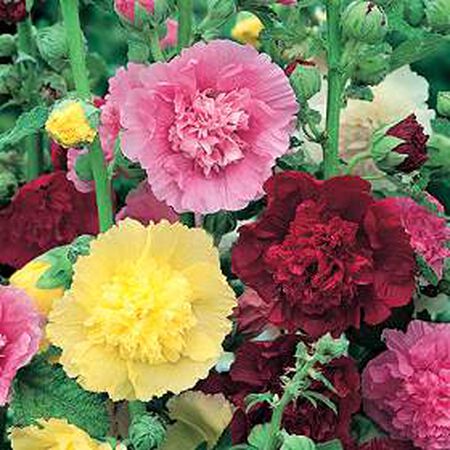Carnival Mix, Hollyhock Seeds
Out of Stock
Key Attributes
Key Attributes
Product Details
Plant Height
3-8'Botanical Name
Alcea roseaSeed Type
SeedAdditional Characteristics
Attracts PollinatorsSeeds Per Gram
99Seeds Per Pound
45,000Packet
50 SeedsSow Depth
1/4"Seeds Per Ounce
2,813Breed
Open-pollinatedSun
Full SunUses
Cut FlowersLife Cycle
PerennialSow Method
TransplantCategories
Flowers,HerbDays To Maturity (# Days)
90Components
Growing Instructions
![]() Learning Download: How to Grow Hollyhock
Learning Download: How to Grow Hollyhock
Hollyhocks are an impressively beautiful flower with stalks that can reach up to nine feet tall. The added vertical element will create a unique appeal to your garden.
Before Planting: Direct sow hollyhock seeds outdoors a week before the last frost date. However, if you are planting from seedlings, wait until two or three weeks after the last frost to transplant them outdoors.
Planting: Plant seeds only 1/4 inch deep and space them at least two feet apart.
Watering: Water regularly to keep the soil moist.
Fertilizer: Hollyhocks do not require a lot of added nutrition, but some extra fertilizer or compost may aid in growth a bit.
Days to Maturity: Hollyhocks will bloom all summer long, however have a short blooming period.
Harvesting: When cutting hollyhock stems to add to a bouquet, the flowers will stay fresh longer if you cauterize the bottom of the stem.
Tips: Rust is a common problem attacking hollyhocks. To prevent this issue, be sure to water from below, treat with fungicide and make sure the plant has good air circulation.
Shipping Schedule
Our Seed Promise
 "Agriculture and seeds" provide the basis upon which our lives depend. We must protect this foundation as a safe and genetically stable source for future generations. For the benefit of all farmers, gardeners and consumers who want an alternative, we pledge that we do not knowingly buy or sell genetically engineered seeds or plants.
"Agriculture and seeds" provide the basis upon which our lives depend. We must protect this foundation as a safe and genetically stable source for future generations. For the benefit of all farmers, gardeners and consumers who want an alternative, we pledge that we do not knowingly buy or sell genetically engineered seeds or plants.
The mechanical transfer of genetic material outside of natural reproductive methods and between genera, families or kingdoms, poses great biological risks as well as economic, political, and cultural threats. We feel that genetically engineered varieties have been insufficiently tested prior to public release. More research and testing is necessary to further assess the potential risks of genetically engineered seeds. Further, we wish to support agricultural progress that leads to healthier soils, to genetically diverse agricultural ecosystems, and ultimately to healthy people and communities.
To learn more about the "Safe Seed Pledge" please visit www.councilforresponsiblegenetics.org.

